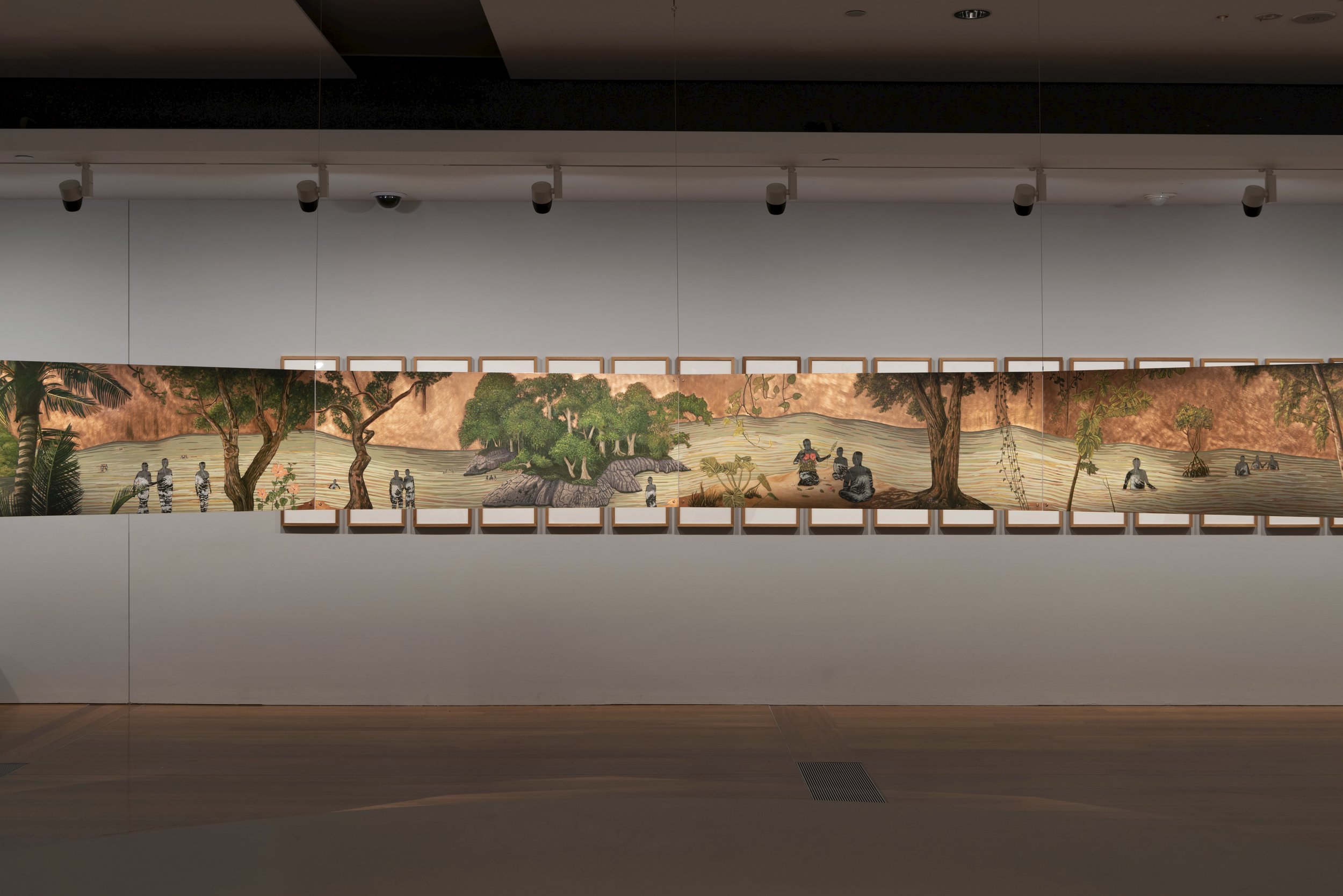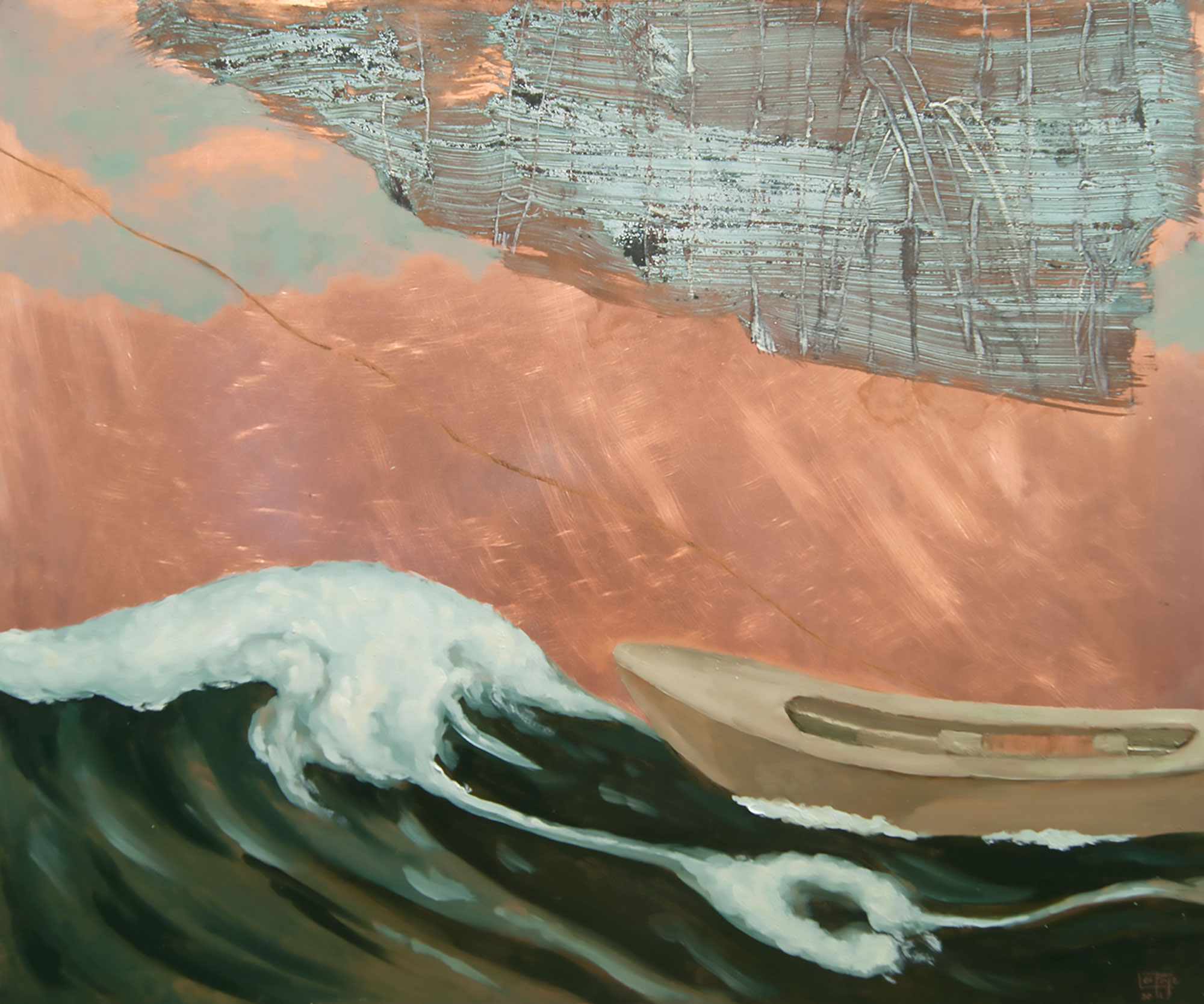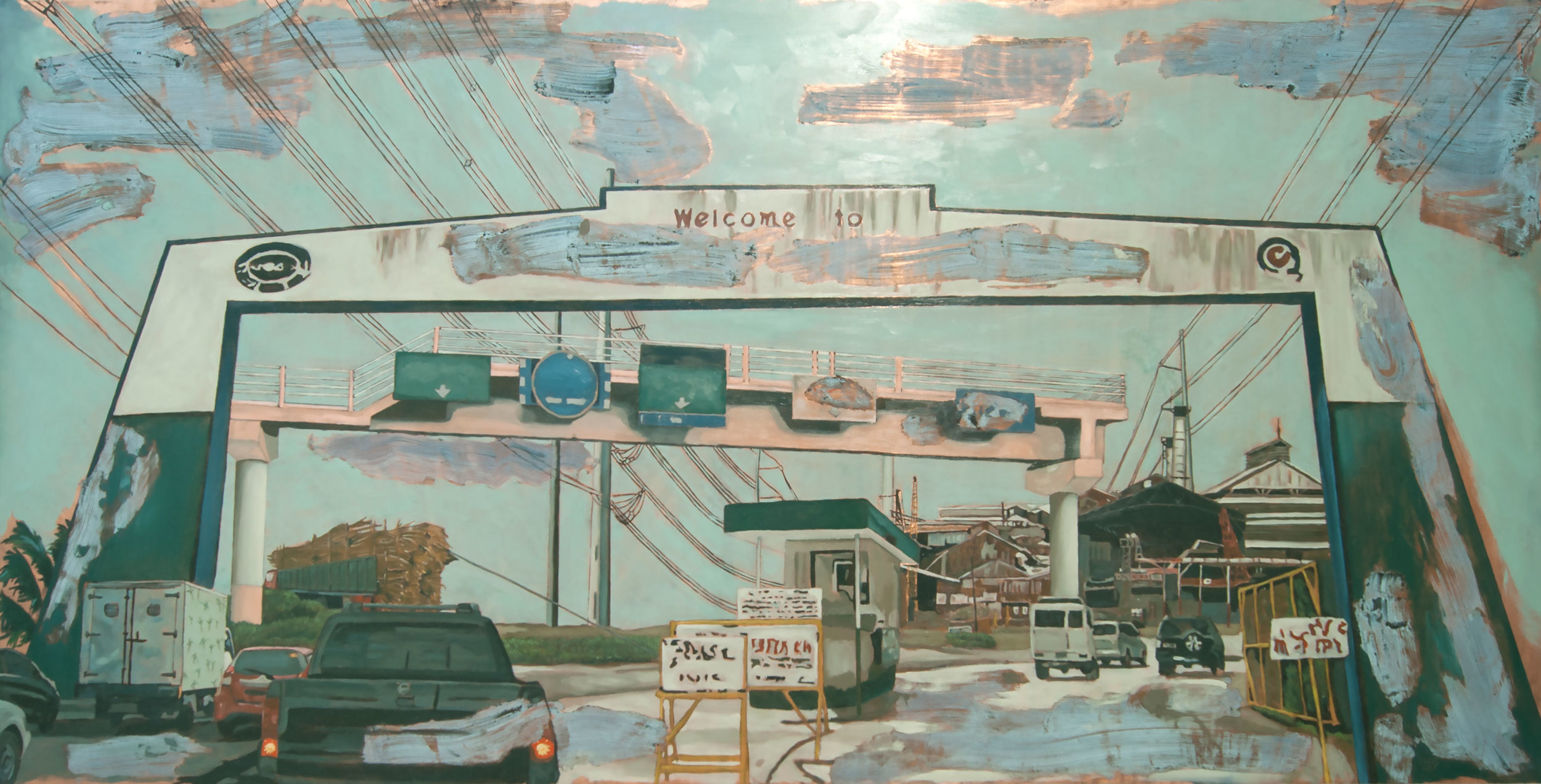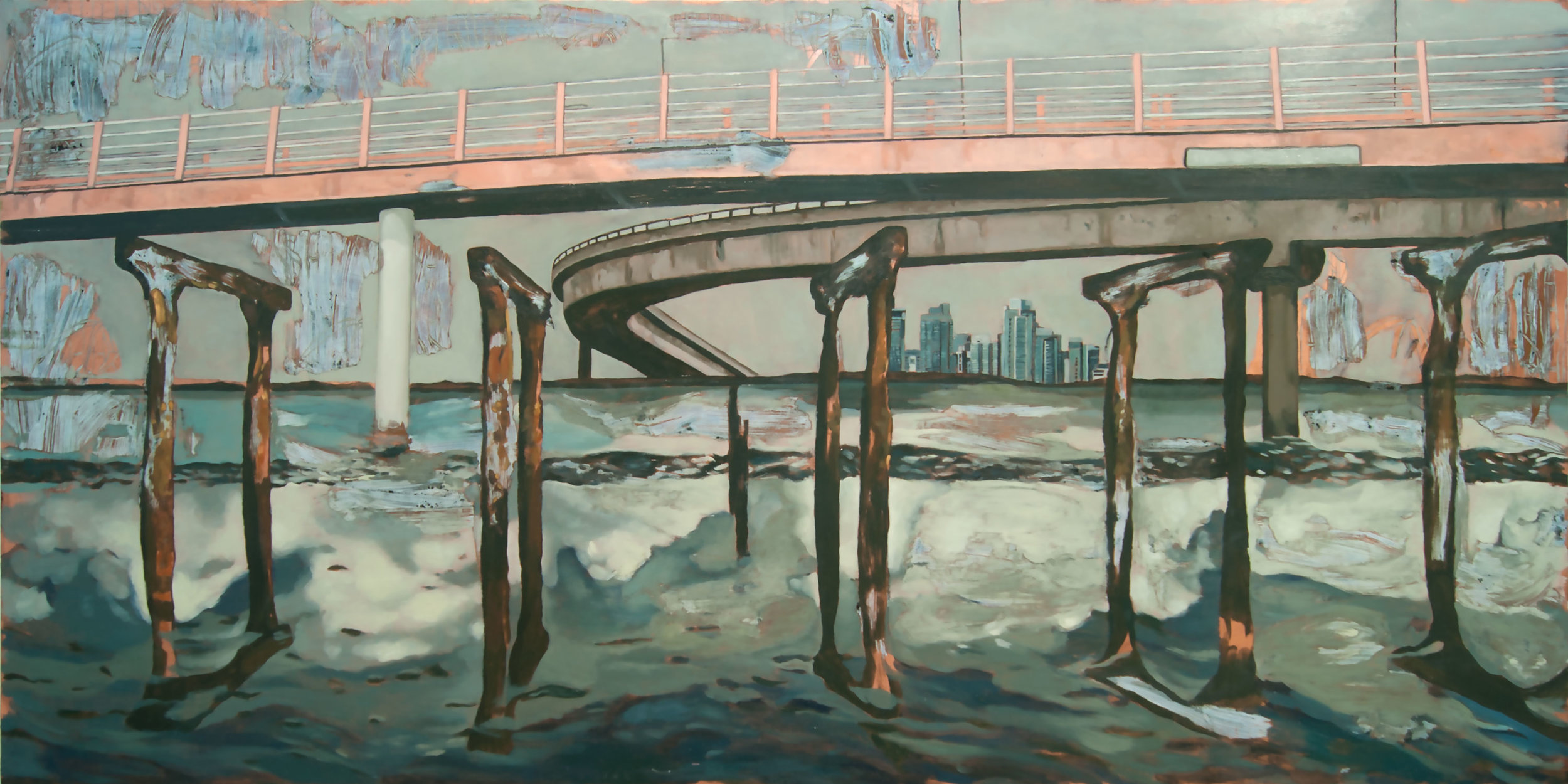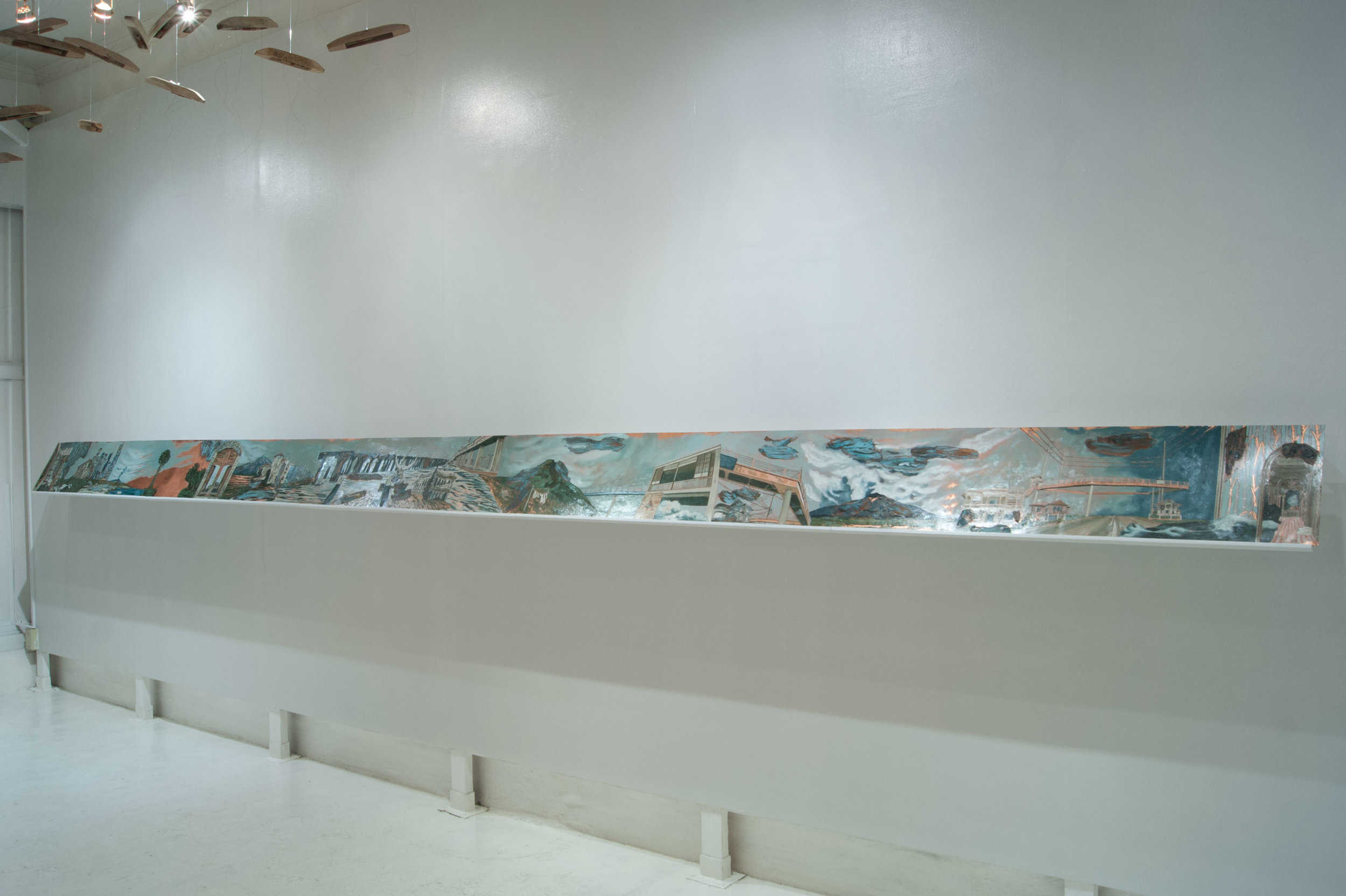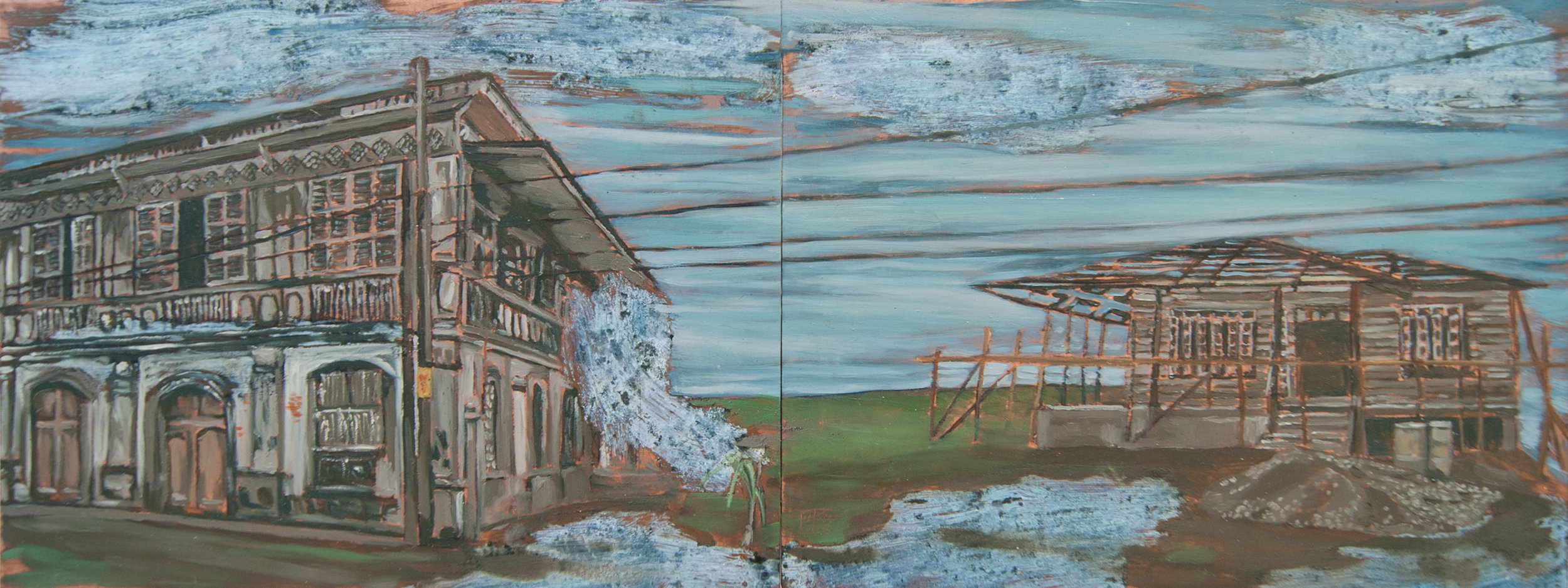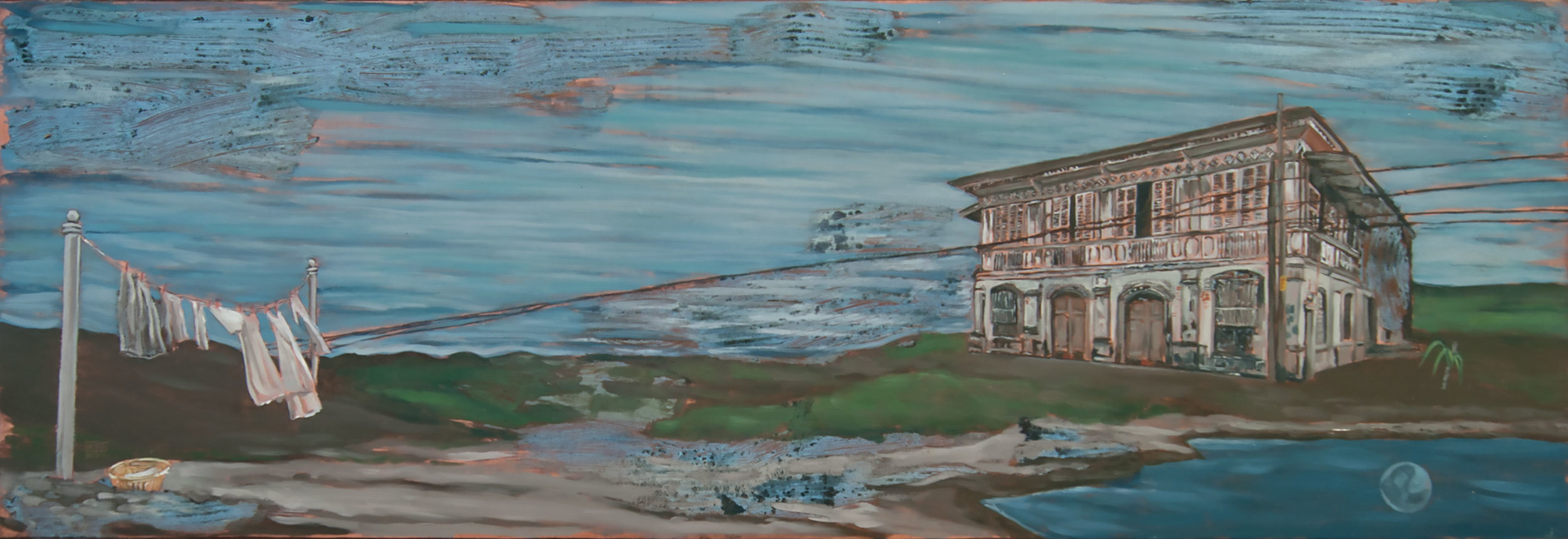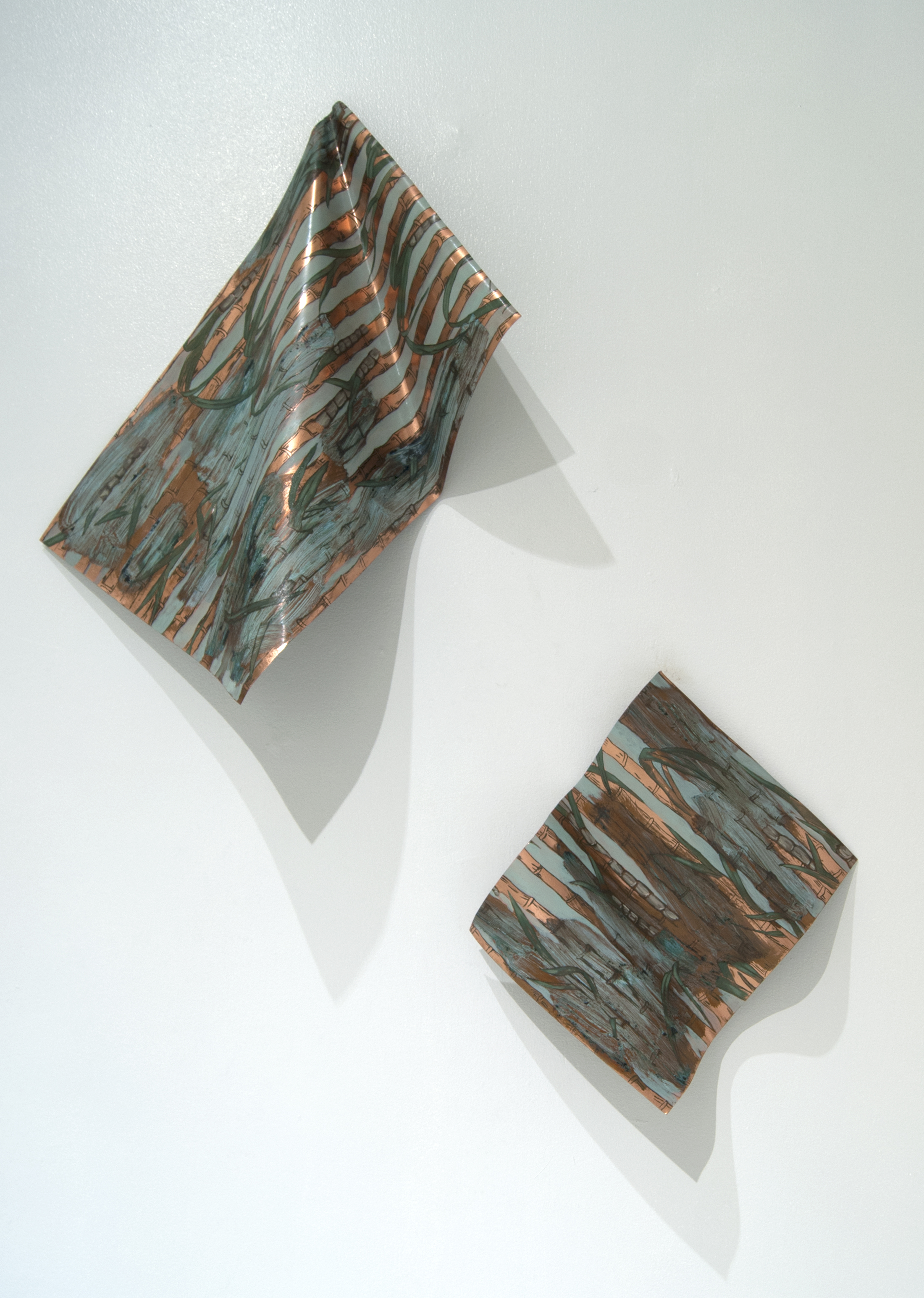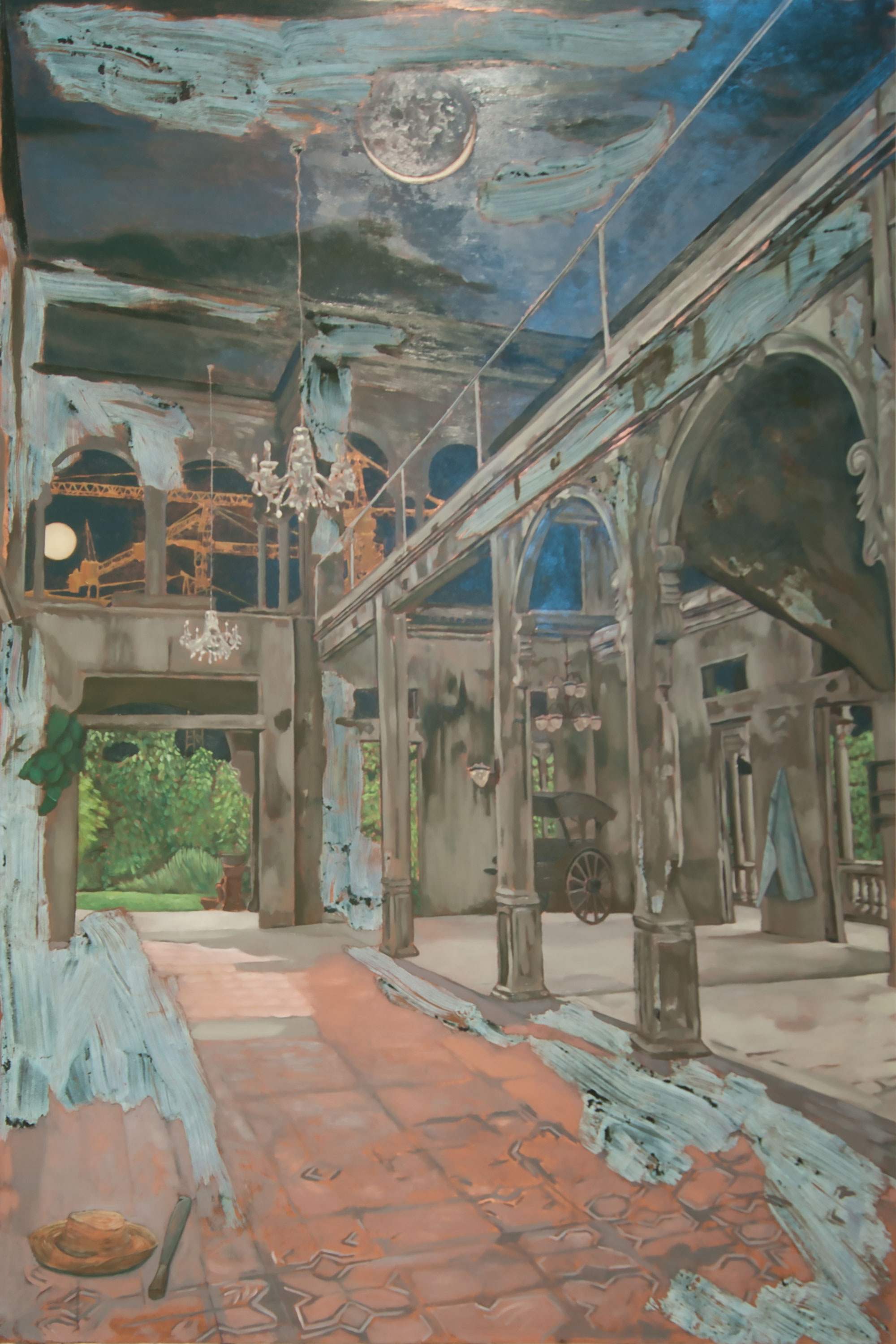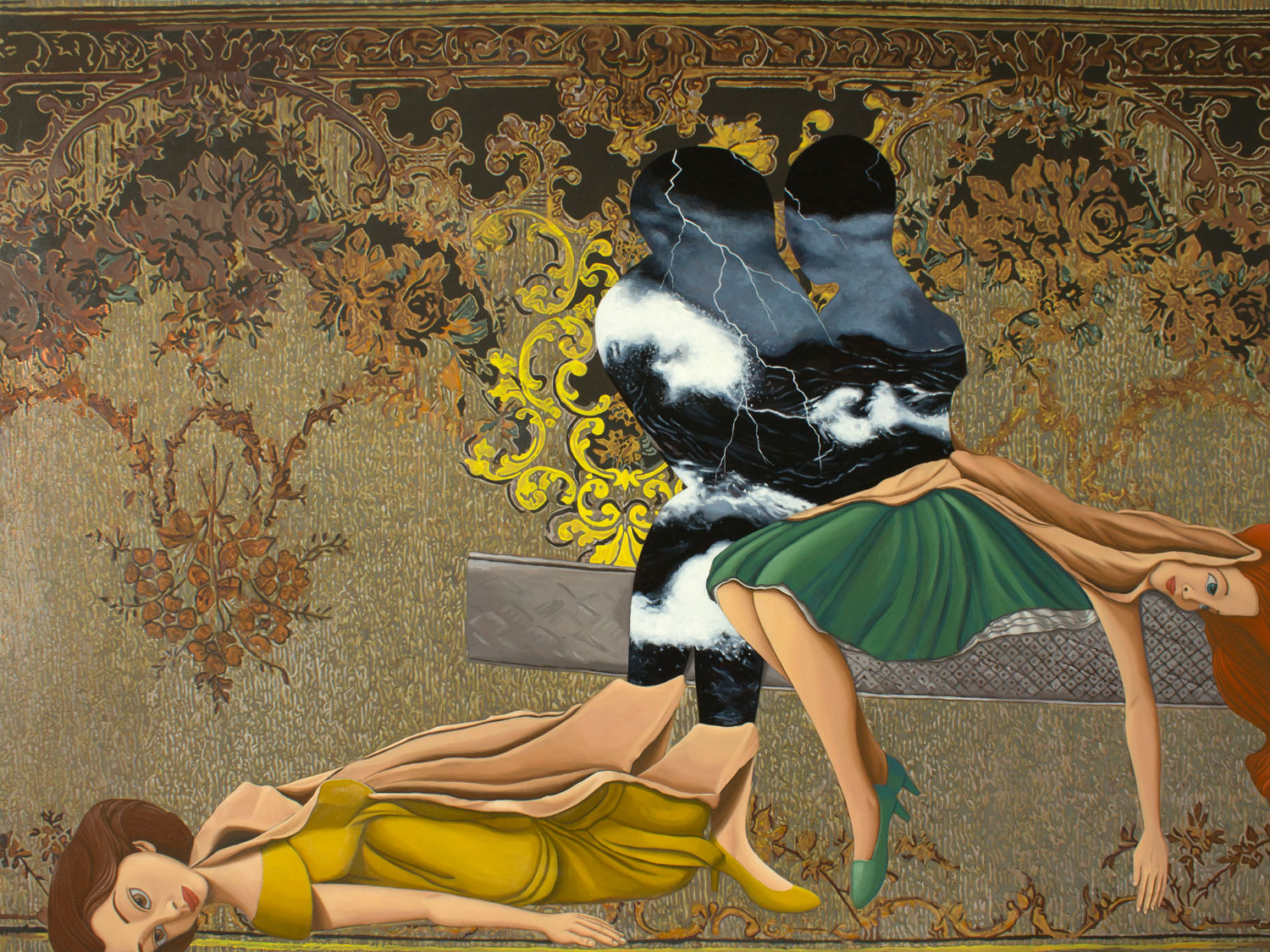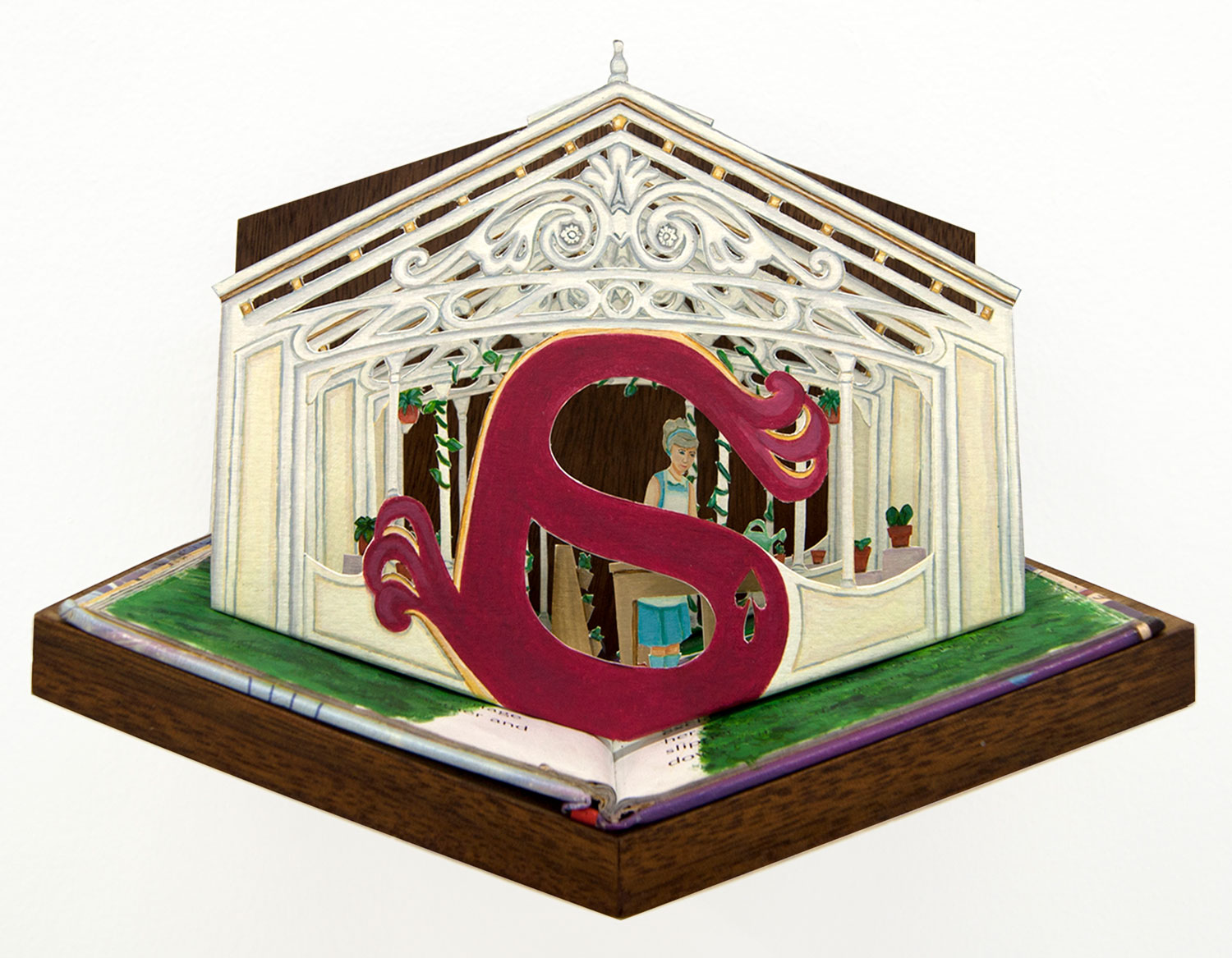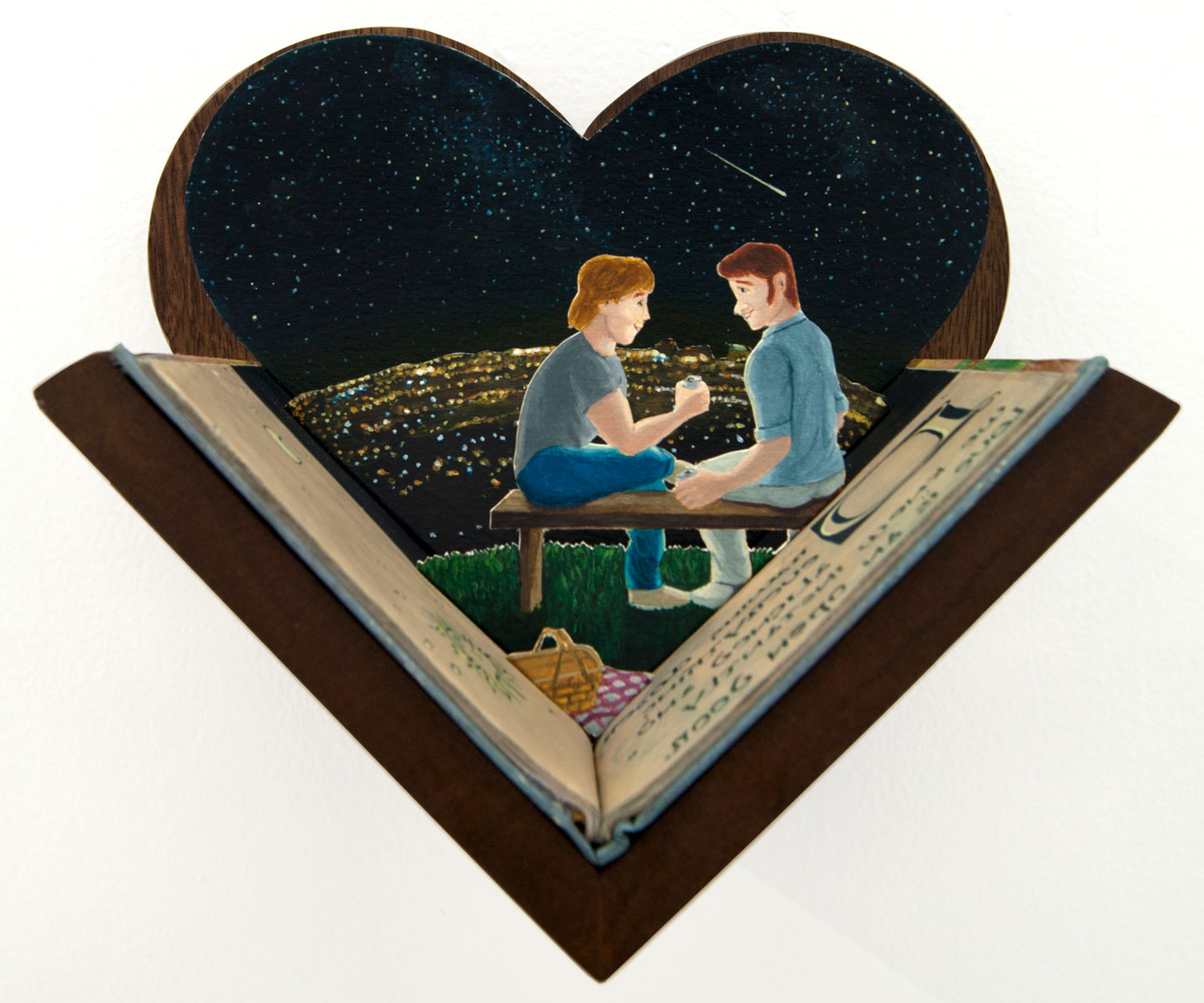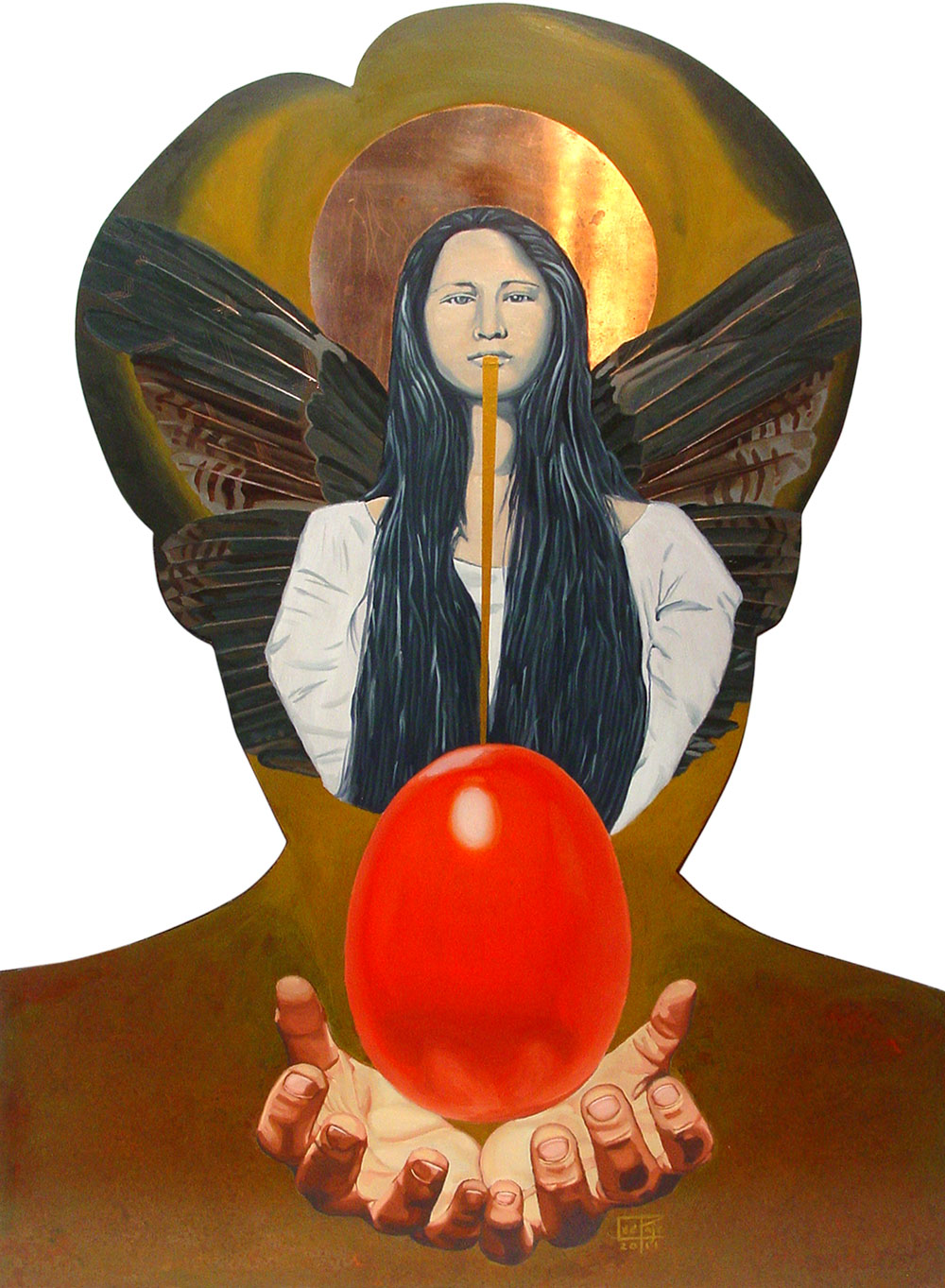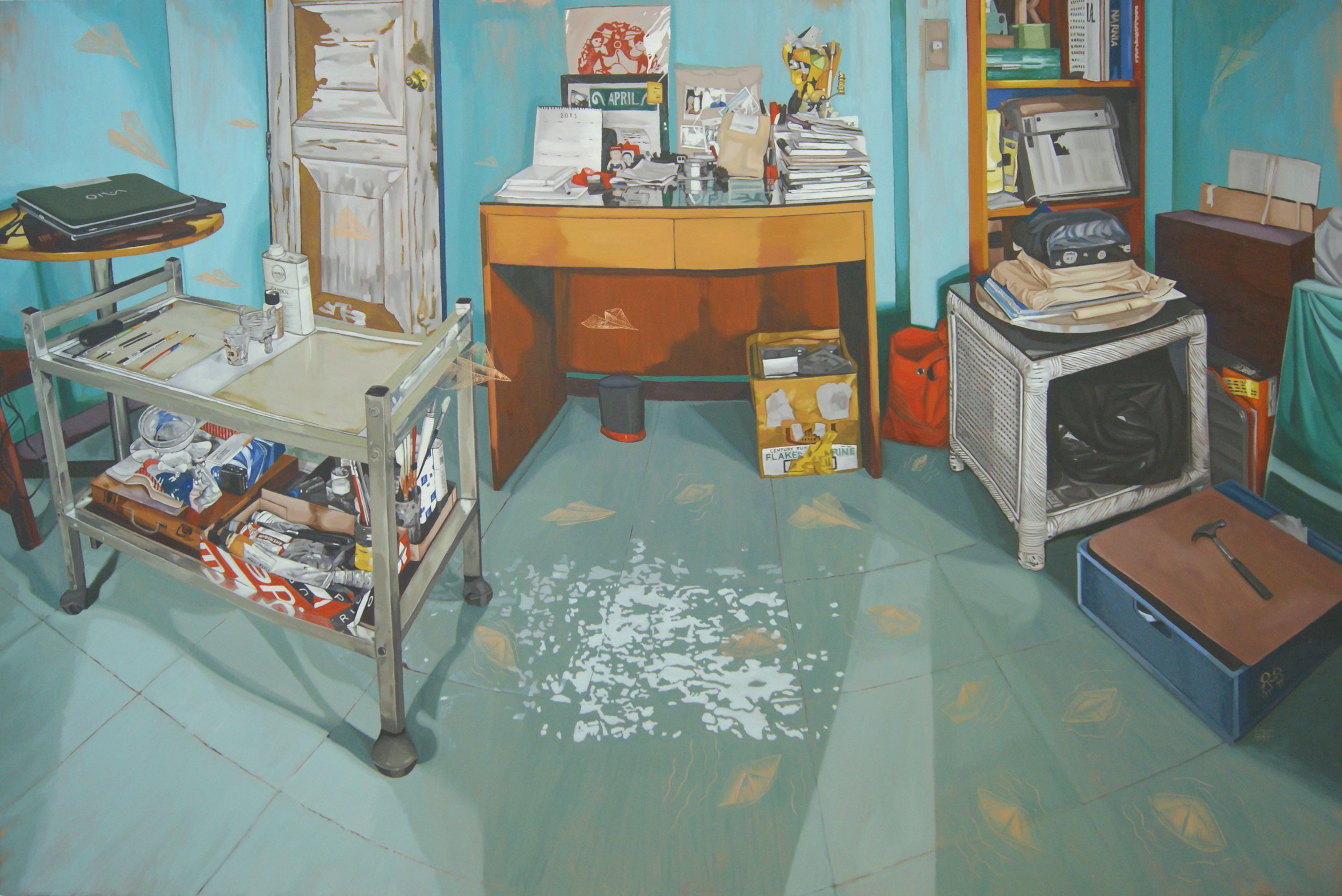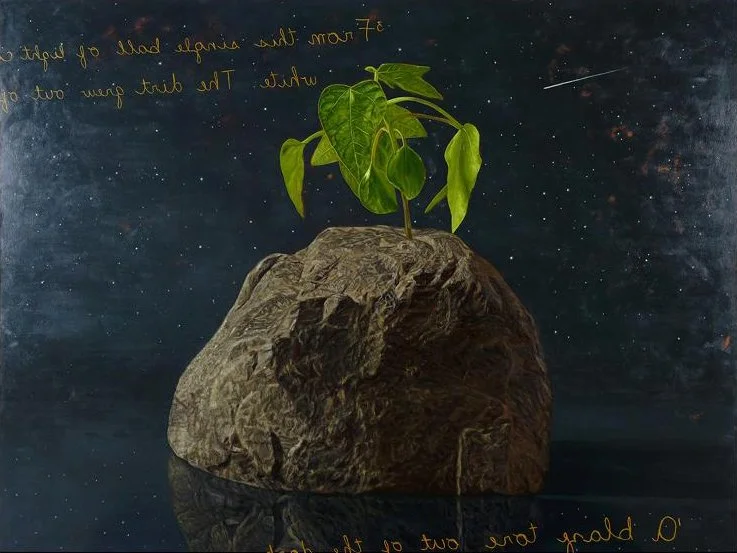Exhibitions
EXHIBITIONS
THE 10TH ASIA PACIFIC TRIENNIAL OF CONTEMPORARY ART
4 December 2021 to 25 April 2022
QAGOMA
Queensland, Australia
The Stories that Weren’t Told 2019 shows an imaginary landscape, melding elements from Filipino and Judeo-Christian origin myths into a hybrid creation story that envisages a new form of paradise. This exquisitely executed triptych painting on copper panels, which took more than three months to complete, draws on and transforms a formative childhood memory for Paje.
When she was six, Paje was ill and made frequent visits to a children’s hospital in Quezon City. At this young and impressionable age, she often passed a huge mural, one of many artworks commissioned to decorate the hospital’s walls. The mural illustrated a creation myth from the pre-Spanish, pre-Catholic era, in which the first humans — a man and a woman — emerged from the two halves of a split stalk of bamboo.[1] Marvelling at the image, Paje asked the nurses in the hospital what it meant; she was told it indicated how a man and woman were made for each other, as two parts of one whole. The title of the Tagalog origin myth, Malakas at Maganda, translates loosely as ‘The Strong and the Beautiful’, with the desirable attributes for each gender implied by the title. Even at such a young age, Paje felt she did not fit the mould or aspire to its outcome.
The Stories that Weren’t Told is Paje’s response to the story of Malakas at Maganda. Throughout her practice, she has painted on copper — a now uncommon medium that was frequently used by artists during the Renaissance prior to the introduction of canvas and is particularly associated with grand narratives. Paje was attracted to copper for its link to Bible stories that reinforce gender stereotypes, as well as for its durability. The copper allows her to assert the ongoing loyalty and endurance of her work and her resolution that it will continue to challenge prevalent social, historical and cultural stereotypes.
Her triptych shows a landscape combining elements of tropical and temperate vegetation, with fruit trees and bamboo, around a central pool or lake. The copper shines through the paint, forming part of the composition and lending a luminousness to the scene. The landscape is populated by a group of primordial beings, unbound by gender, envisaged by Paje as human outlines filled with limitless and mysterious seascapes, like portals into the unknown. These beings are able to cast off the skin that defines their gender and identity as though it were a piece of clothing. In the foreground is a single primordial figure whose recognisably female skin lies on the ground near a half-eaten apple — the Christian symbol of original sin that saw Adam and Eve expelled from Paradise into a world of hardship and evil. In Paje’s painting, Eve’s sin has already taken place, yet humans still occupy this new paradise. A couple identifiable as Adam and Eve stand beneath a fruit tree. On the left, fluid ungendered humans emerge from stalks of bamboo in pairs while, in the far background, smoke rises from a city in flames.
Stemming from the themes and symbols in her triptych, Somewhere, someday when we are the sea 2021 (illustrated) takes the form of a polyptych (historically an altarpiece of linked panels). Each panel is linked and suspended from the ceiling to allow the viewer to physically enter the space of the painting and to create an immersive experience. In Paje’s words:
A continuous landscape of different topographies forms once the panels are united. Viewers are invited to enter, traverse the space, partake in the journey with the primordial beings that roam the landscape and, perhaps, glimpse a paradise, a future.[2]
For the artist, the contrasting experiences of the polyptych and the triptych are significant, as the bodily mode of engagement contributes to an understanding of the way we ‘receive, remember and render signals from social, economic and cultural constructs’.[3] The viewer becomes the thread that ties the two works together and connects the meaning of the whole. Within this liminal space, with its forest and glades and vast internal seascapes, we are able to re-create the stories we were told and imagine new ones that represent us.
(written by Abigail Bernal, Associate Curator, Asian Art, QAGOMA)
Endnotes:
^ The mural by artists Victor Cabisada and Peter Alcántara, Si Malakas at si Maganda 1980, is at the Philippine Children’s Medical Center, Quezon City.
^ Paje.
^ Paje.
[Photo credits to Merinda Campbell]
TO WALK WHERE NO ONE SEES AN OTHER
8 December 2018 to 9 January 2019
Tin-aw Art Gallery
Makati City, Philippines
The artist paints on copper, a material which attracts her because of its malleability. Its surface requires more energy and labor, receiving and sealing images through immense attention and care. It also has a surface sheen that shows through her renderings. It allows her to handle mediums with varying densities, and to make her palette alternatively brilliant and subdued. Copper as ground also has an otherworldly quality whether through brilliance or form. It can be structured like a typical ground or in sheets that take on specific configurations. Its sheen can be modulated; to function as receptive surface to oil or a visual device to connote a vision and frame a narrative. In this exhibition, the artist coaxes her material to bend and meet spherically, like the roaming eye that takes in a panoramic view. We find her exploring the ‘installative’ as a means to relay a story or more precisely, to make a world.
The installation format that is multilevel and spherical would require viewers to enter a space that is site of art and where other sites of being can be imagined. The middle copper sheet can be visual appendage, an extension of the eye. The format began with experiments on copper scrolls, more like Chinese landscape paintings that challenge the visual order of the common world. These have taken a sculptural form for the current exhibition, exploring Lee’s articulation of space that can be simultaneously depicted and constructed. Yet the artist speaks to more than a relay of sceneries. Her panoramas are about a vision of a world that is accepting of difference, a place not divided by it. This installation format calibrates looking by allowing the body to move with the gaze. How does it feel to gaze up or look down, or be enmeshed within a relay of images? The experience can be exhilarating or disorienting, it can also be chaotic or comforting but what it certainly implies is that images make a complex field of meaning.
Lee Paje’s panoramic relays both ground and elevate us, making us aware of the finitude of our world and allowing us a vision of how she imagines it to be boundless and encompassing. Through her works, sceneries and places are founded on being in place.
(Excerpt from Vista of Dreams by Tessa Maria Guazon)
[Video credits to Monica Mendoza]
DIIN, SAN-O, SIN-O
17 November - 7 December 2017
Kapitana Gallery
Talisay City, Negros Occidental, Philippines
Diin, San-o, Sin-o is a culmination of her Artist Residency Program with Kapitana Gallery which is located in Talisay, Negros Occidental. Balay ni Tana Dicang, an ancestral house, partly guided the direction of her study and the image of which were featured on many of her paintings for the exhibition. She directed her research on Spanish-era and pre-war buildings and houses that are scattered around Negros Occidental. She notes how these structures which withstood decades of foreign occupation and two world wars have in time become entwined with the very identity of the locale in which they are situated. She has also observed that modernization is, to some extent, redefining the identity of these old structures as new establishments rise up around them.
Based from these realizations, she has come to the conclusion that “spaces make identities and identities make spaces”. Paje then carries over this conclusion in the conception of her artworks for the exhibition. Through her oil on Copper paintings, she attempts to “create spaces that allows redefinition and reorientation of identities”. Her paintings are not merely faithful renderings of landscapes and structures. She takes these landmarks and fuses them with vistas from another locality; some of which are images of modern architecture that is indicative of urban progress. Through this process she is able to create an imagined scene, altogether new but still feels familiar.
An aspect of the discourse not visible in the artworks but are inevitably tackled by the concept are the individual identities of the audience — each coming from diverse backgrounds and with different levels of affinity towards the subjects that will come into play when they interact with the pieces. There will be the locals, who arguably would have the strongest feeling of familiarity with the images. There may also be individuals who, having not seen these sites for a long time because of one reason or another, might be surprised positively or otherwise, to see the changes that they have undergone. There might even be those who will be exposed to the sceneries for the first time; their reactions a little harder to predict. Regardless of background, each individual’s reaction to the reimagining of these landmarks will always reveal a part of their identity. Through the the exhibition the artist hopes to compel the audience to ask themselves: Diin kita? (Where are we?), San-o ini? (When is this?), Sin-o kita? (Who are we?).
(Excerpt from Landmarks by Ioannis Sicuya)
UNEXPURGATED
07 - 29 OCTOBER 2016
Tin-aw Art Gallery
Makati, Philippines
A continuation of her work in the 2013 group show Childhood Games People Play in Singapore, Lee Paje once again takes inspiration from children’s books in Unexpurgated. This time however, popular tales from the Disney collection serve as the nucleus albeit in alternate configurations.
Gender is conventionally perceived as a rigidly binary classification: all humans are divided in terms of anatomy into the disjunctive categories of either male or female, of which certain codes such as taste, clothing, and mannerisms are ascribed to one or the other, never neither nor both. The belief that to deviate from this is to be an anomaly remains prevalent and deeply entrenched in our society, as strongly enforced by various institutions and state apparatuses—families and schools included. Alarmingly, the conditioning process haphazardly dictating the ideology of what is supposedly “natural” is quite pronounced in the majority of books aimed at children.
Through paper sculptures and oil on copper paintings, the artist reworks these heteronormative narratives to personally fit her own experiences. Well-known characters inhabit an intricately assembled surreal and fantastical mirrors-and-flora mise-en-scène as participants in scenarios designed to represent the vast spectrum of gender, sexuality, and preference—facets of life such tales typically shy away from. And this is essentially what Paje seeks to accomplish with Unexpurgated; to shed light on the complexity of gender as well as contemporary lifestyles barely visible in popular media, in the hopes of transforming the audience through the fostering of respect and understanding for the nuances of identity.
ART TAIPEI: YOUNG ARTIST DISCOVERY
SOMEWHERE BEYOND RIGHT AND WRONG, THERE IS A GARDEN. I WILL MEET YOU THERE
31 OCTOBER - 03 NOVEMBER 2014
Taipei World Trade Center
Taipei, Taiwan
Lee Paje chooses the intricacies of gender and sexuality for her solo exhibition at Art Taipei 2014. The title “Somewhere beyond right and wrong, there is a garden. I will meet you there.” was adapted from the movie Diana (2013), but goes beyond the film’s theme of scrutinising a forbidden private affair, and is rather a scrutiny of various gender stereotypes.
The selection of works is comprised of two variants, that of idealised male and female torso forms ambushed by moustached scissors and oil on Copper paintings of non-traditional gender scenes intertwined with religious artistic design. These artworks delve into the question of identity, as brought about by judgements of gender and sexuality, which is a constant exploration Paje’s works.
Visually engaging, Paje’s exhibition asks the viewer to scrutinise gender stereotypes and to go beyond what is arguably “right” and “wrong”. Rather than passing on judgement towards individuals who exist outside perceived “societal norms,” Paje seeks to emphasise these identities.
BIGOTED
15 MARCH - 03 APRIL 2013
Manila Contemporary
Makati, Philippines
Rising young artist Lee Paje selects the complications of gender and sexuality for her first solo in Manila Contemporary. The title of the exhibition is a word play on the Tagalog for mustache (‘bigote’) and the English (‘bigoted’) which describes an intolerant or narrow minded individual. This provides a playful entry point into issues of discrimination faced by the LGBT community through a surreal installation made up of idealized male and female forms being attacked by mustachioed gold scissors.
Identity, through sexuality and gender readings, are a continuing line of inquiry for the artist who often integrates Filipino folklore and religious texts into her works to destabilise fixed assumptions on who we should and shouldn’t be. In BIGOTEd she has been inspired by the creation myths of the first man and woman from Philippine folklore ‘Malakas at Maganda’ whose very names ‘Strong’ and ‘Beautiful’ fuel the powerful, and limiting labels placed upon men and women in society today.
Gender and sexuality are fluid concepts determined by a constantly changing set of experiences, choices and ideologies. However, structures of power tend to hold on to rigid definitions, set within heterosexual and procreative terms for control and dominance. Paje’s men and women therefore function as assaulted gender identities, swarmed by bigoted scissors, whose moustached forms symbolise a critical and oppressive patriarchy intent on ‘cutting out’ individuals who exist outside perceived ‘ social norms’. Visually arresting, this is a judgment in process, of masculine and feminine bodies in flux, suffering at the hands of those who chose not to understand or accept their identities.
MATER POTESTATEM
05 - 26 AUGUST 2011
Tin-aw Art Gallery
Makati City, Philippines



